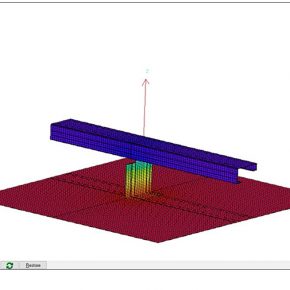
A Hush Acoustics article: Acoustics and Autism in Education
One in a hundred are diagnosed with Autism. It is estimated that there are 700,000 people in the UK who are on the Autism continuum, 100,000 of which are children. Despite the high statistics, awareness around environmental impact for autistic individuals is still relatively low and so we wanted to create awareness around how our environment can have a major impact on their wellbeing.
Autism is a developmental disability and many people on the spectrum have difficulty processing everyday sensory information; Sight, Sound, Smell, Taste and Touch. Abnormalities in Auditory processing are one of the most commonly reported sensory processing impairments in children with Autism.
Many can either be Over (Hypersensitive) or Under (Hyposensitive) sensitive to Sound. This is of particular interest to Hush as the built environment provides the large majority of sensory input – acoustics, light, colours etc and being experts in the design and manufacturing of soundproof products and systems we can help in the manipulation of the design of our environment and therefore important sensory input.
Those who are Hyposensitive to sound may:
– Only hear sounds in one ear, the other ear having partial hearing or even none at all
– Not even acknowledge particular sounds
– Might enjoy crowded & noisy places
– Like to bang doors or objects together, or even speak in loud tones to seek the sensation
Those who are Hypersensitive to sound may:
– Be able to hear conversations in the distance
– Have an inability to cut out sounds such as background noise which leads to difficulties concentrating
– Sound may be magnified
– Sound can become distorted
These sensory challenges can cause stress, anxiety, and possibly physical pain if they are not managed correctly. This can result in withdrawal or challenging behaviour which at times can be extreme.
Education is a key part of every child’s life and whilst there are specialist schools available, 71% of children with Autism attend main stream school.
Some research has shown that there are little architectural guidelines in place of what requirements are needed when designing and building educational spaces to the levels required for children who have Autism specifically, although BB93 Acoustics In Schools Guidance does ‘touch’ on the subject. However, one associate from ‘progressive architects’ who is a specialist in special needs design, has put together a matrix to help people when designing these spaces.
Dr Mostafa’s ‘The Autism ASPECTSS™’ outlines 7 design criteria, to help towards positive behaviour and skill development in people with Autism. These criteria are; Acoustics, Spatial sequencing, Escape, Compartmentalization, Transition spaces, Sensory zoning and Safety. Dr Mostafa highlighted Acoustics to be an influential factor in the need to minimise background noise, echo and reverberation to suit the individual and level of focus required. What acoustic specification is needed will vary according to the level of focus that is required for the activity at hand, as well as the skill level and severity of the autism of the individual. Activities requiring more focus, should take place in “low stimulus zones” and therefore the space for this requires more acoustic control to keep the background noises, echoes and reverberation noises to a minimum.
For those with Hyposensitivity, a space where the individual is able to go and seek the stimulus of loud noises should be created and this would require good soundproofing to ensure there are no affects on others studying elsewhere.
Their sensory experiences can mean that there are a number of modifications that should be taken into account to make environments, buildings and architecture, autism-friendly.
The SEN and Disability Act 2001 in schools describes how schools must improve access to the physical environment by making specific developments and adaptations to buildings (including furniture and fittings) to facilitate the inclusion of identified children with special educational needs and disabilities. In any future modernisation, refurbishment or building plans, schools are required to place due importance on securing access for disabled pupils.
Hush Acoustics work with Architects & Specifiers to ensure that when a building is designed we meet the minimum requirements of Document E, Section 5 or Part G (across the UK) and when working in the Educational sector we offer advice and design guidance in line with the BB93 Acoustics In Schools Document. We also have the ability and the awareness to create more suitable spaces for those with special educational needs. We seek to improve building designs & refurbishments with our expert knowledge to ensure a more inclusive environment and contribute to raising awareness of good acoustics in schools.
Latest news

26th July 2024
Enfield Speciality Doors completes world-class project for Atlas Copco HQ
A rundown office and warehouse building completely transformed into a modern headquarters for Atlas Copco has been fitted with more than 120 internal fire doors from Enfield Speciality Doors.
Posted in Access Control & Door Entry Systems, Articles, Building Industry News, Building Products & Structures, Building Systems, Case Studies, Doors, Interior Design & Construction, Interiors, Posts, Restoration & Refurbishment, Retrofit & Renovation, Security and Fire Protection, Sustainability & Energy Efficiency, Timber Buildings and Timber Products, Wooden products
26th July 2024
Abloy UK launches new white paper
Abloy UK, a leading provider of security and access control solutions, has launched a new white paper.
Posted in Access Control & Door Entry Systems, Architectural Ironmongery, Articles, Building Industry News, Building Products & Structures, Building Services, Doors, Facility Management & Building Services, Health & Safety, Information Technology, Innovations & New Products, Publications, Research & Materials Testing, Security and Fire Protection
26th July 2024
MCRMA Member Profile: David Roy, Director of Roofconsult
David Roy of MCRMA member company Roofconsult has more than 50 years’ experience to draw upon working in the building envelope sector and a unique perspective on how it has changed in that time.
Posted in Articles, BIM, Infrastructure & CAD Software, Building Associations & Institutes, Building Industry News, Building Products & Structures, Building Services, Building Systems, Cladding, Information Technology, Restoration & Refurbishment, Retrofit & Renovation, Roofs, Walls
26th July 2024
Strand: Enhancing Door Functionality and Safety
Craig Fox, Sales Director for Strand Hardware, outlines how door industry professionals might apply door limiting stays…
Posted in Architectural Ironmongery, Articles, Building Industry News, Building Products & Structures, Building Services, Doors, Facility Management & Building Services, Health & Safety, Restoration & Refurbishment, Retrofit & Renovation
 Sign up:
Sign up: